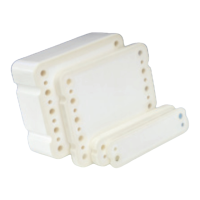16
(iv) Stop tightening each nut immediately when the torque wrench “clicks,” or the wrench arm
pivots slightly away from the socket indicating that the nut has reached the correct torque.
Continue torquing each nut in sequence until the torque wrench “clicks” immediately on
each nut in sequence. If torqued properly, the nuts should reach the set torque value at
about the same time. The indication that the torque wrench has reached the set value may
be very subtle. Therefore, tighten the nuts slowly to prevent exceeding the required torque
value.
Note: At this point in the installation, the hold-up volume and minimum working volume should
be determined. See Section 3.3.
4. After cassettes have been installed and flushed with water, the system should be inspected
for leaks. If liquid is found leaking from around the cassettes, increase manual torque in 10%
increments or the hydraulic pressure in increments of 3 barg (45 psig). Flush the system with
water and check again for leaks. Stop increasing the hydraulic pressure when no more leaks
are observed. With the system filled with water, pressurize it to exceed the maximum
expected process operating pressure by about 10%.
Warning: Do not exceed pressure limits for the cassettes and system components or torque
and hydraulic compression limits.
Check for leaks. If liquid is found leaking from around the cassette, increase manual torque in
10% increments or the hydraulic pressure in increments of 3 barg (45 psig). Stop increasing
when no more leaks are observed.
Warning: Do not exceed the maximum recommended torque or hydraulic pressure.
If liquid is found leaking from around fittings, check the fittings and gaskets. Replace if
necessary. Once properly installed and compressed in the holder, cassettes can be pre-
conditioned and used in a process. A forward flow air integrity test including a system integrity
(pressure hold) test should be performed prior to adding product to the system (Section 4.6).
5. Periodically check the torque on each bolt for MT holders. Cassettes will compress initially
upon installation and will require adjustment. Temperature changes to the environment or
feed solution may require a torque adjustment to the holder. AT holders compensate for
reduced cassette compression and normally do not require periodic adjustment of the
hydraulic pressure.
Caution: Increasing the temperature of the feed solution will cause expansion of the cassettes,
causing the clamping force to increase unless the torque on MT assemblies or hydraulic
pressure on AT assemblies is relieved or reduced. It is possible that the maximum clamping
force may be exceeded. If a heated solution will be pumped into the cassette system, set the
clamping force on both MT and AT holders just below the minimum setting prior to adding the
heated fluid.
When finished using a calibrated torque wrench, adjust the wrench to its minimum force setting
for storage. Leaving a torque wrench set to a higher value can cause it to go out of calibration.
The torque required to apply the correct clamping force on cassettes depends on the size and
number of tie rods and the surface area over which the force is applied. On Pall AT hydraulic
closure systems, it also depends on the diameter of the pistons. Values listed in Table 1 and
Table 2 are recommended for cassettes from Pall Life Sciences. When installing cassettes from
Pall Life Sciences in holders from other manufacturers, contact Pall with the specifications of
the holder so that the correct torque or hydraulic pressure can be determined.
Caution: Excessive compression can permanently damage the cassette.

